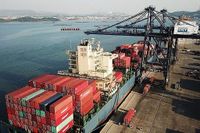Vietnam’s export sector is racing toward the end of 2025 with both impressive gains and daunting challenges, as shifting global policies and economic uncertainties put pressure on the nation’s key industries. Despite a robust start to the year, with export turnover nearly reaching $262.5 billion in the first seven months—a surge of almost 15% compared to the previous year—business leaders and policymakers are urging caution and strategic adaptation for the months ahead.
According to the US Department of Agriculture (USDA), Vietnam’s rice exports are expected to hit 8.2 million tons in 2025, representing an increase of 300,000 tons over previous forecasts. This upward revision is attributed to strong demand, especially from African markets and China. Speaking to local media, Do Ha Nam, Chairman of the Vietnam Food Association (VFA), expressed confidence in the sector’s trajectory: “With the export results achieved in the first seven months of the year, it is projected that Vietnam will export over 8 million tons of rice in 2025, securing the position as the world’s second-largest rice exporter, thanks to building a distinct brand favored by many markets.”
However, the path is not without obstacles. The Philippines, a major buyer, temporarily suspended rice imports for two months—a move that sent ripples through the industry. Yet, as reported by Nhan Dan, the impact was not as severe as some feared, largely due to Vietnam’s diversified export destinations and the resilience of its agricultural sector. The USDA’s forecast suggests that the sector will more than compensate for this temporary setback, especially as demand from other regions surges in the final months of the year.
While rice remains a star performer, Vietnam’s broader export landscape is facing a critical test. As noted by Nguyen Ngoc Hoa, Chairman of the Ho Chi Minh City Business Association, the second half of 2025 is expected to be even more challenging than the first. “Vietnam is an open economy, and exports are a key pillar of growth. Major export sectors like textiles, footwear, furniture, and agricultural products bring in tens of billions of dollars each year, but could be affected as global consumer demand softens,” Hoa warned in an interview with Tin Nhanh Chung Khoan.
One of the most pressing concerns is the United States, which accounts for a significant share of Vietnam’s exports. In the first seven months of 2025, Vietnamese exports to the US reached $85.1 billion, marking a 27.8% increase. Yet, the mood among exporters is anything but complacent. The specter of new US tariffs looms large, threatening to erode hard-won market share and disrupt supply chains. Phuc Sinh Group, a leading agricultural exporter specializing in coffee and spices, has already felt the tremors. “Since the US announced its tariff policy, both our American consumers and partners have expressed concern, as they use a lot of Vietnamese spices like pepper, cinnamon, and star anise,” a company representative shared. “Our US customers are now more cautious about the volume and timing of their orders, which is impacting the entire supply chain back in Vietnam.”
The textile industry, another export powerhouse, is also bracing for a turbulent finish to the year. Det 8/3 Textile Company reported production of 6,832 tons of fiber in the first seven months—just 51.7% of its annual target—with revenue at 460 billion VND (about 50% of the plan) and cumulative profit at 800 million VND. General Director Vien Minh Dao noted, “The textile market is expected to face continued difficulties in the last months of 2025, which will directly affect our production and business activities.” The immediate goal for the company is to ramp up organizational capacity and expand its customer base, aiming to meet its full-year targets despite the stiff headwinds.
To weather these storms, Vietnamese businesses are not sitting idle. Many have implemented measures to adjust production and cut costs in anticipation of reduced demand and higher tariffs. In the short term, companies are accelerating shipments and sharing tariff risks with import partners. Over the longer term, the industry is focused on diversifying markets, improving management efficiency, and developing new products—while paying close attention to rules of origin to avoid the pitfalls of transshipment when exporting to the US.
Economic experts are keeping a close eye on the global picture. BIDV’s chief economist Can Van Luc, who also serves on the National Advisory Council for Financial and Monetary Policy, commented that Vietnam’s export performance in the last five months of 2025 will depend on a range of factors, most notably the state of the global economy. “The biggest concern is that many forecasts point to a slowdown in the world economy in the coming months, driven by trade tensions and geopolitical uncertainties,” Luc observed.
The World Trade Organization (WTO) reported that global merchandise trade volume grew by 3.6% in the first quarter of 2025 compared to the previous quarter, and by 5.3% year-on-year—exceeding earlier projections. This growth was fueled largely by a 13.4% surge in North American imports, as businesses rushed to purchase goods before new US tariffs took effect. However, the WTO cautioned that this momentum is likely to slow in subsequent quarters, as inventories fill up and the impact of higher tariffs begins to dampen demand.
In response to these shifting dynamics, Vietnam’s government is ramping up trade promotion efforts. The Prime Minister has tasked the Ministry of Industry and Trade with intensifying outreach for Vietnamese products in markets covered by free trade agreements, as well as niche and emerging destinations such as Saudi Arabia, Egypt, the UAE, Brazil, and North Africa. The goal is ambitious: achieve 12% export growth and a trade surplus of $30 billion in 2025.
Looking ahead, the Ministry is coordinating with international partners and major e-commerce platforms, including Amazon and Wayfair, to promote Vietnamese exports in October 2025. The focus will be on high-value sectors like wood products and consumer goods, with Vietnamese companies set to meet US partners at the headquarters of Amazon.com and Wayfair.com—both global leaders in online retail and supply chain innovation.
Adding to the momentum, Vietnam will soon welcome more than 300 global buyers to Ho Chi Minh City for the “Vietnam International Sourcing 2025” event, a major initiative aimed at strengthening the country’s role in global supply chains. Scheduled for mid-September, this event underscores Vietnam’s commitment to deepening its export relationships and exploring new market opportunities, even as the international environment grows more complex.
As Vietnam’s export sector navigates the home stretch of 2025, the stakes could hardly be higher. With a combination of strategic adaptation, government support, and relentless determination, Vietnamese businesses are striving to turn today’s challenges into tomorrow’s opportunities—keeping the nation’s growth engine running, one shipment at a time.




